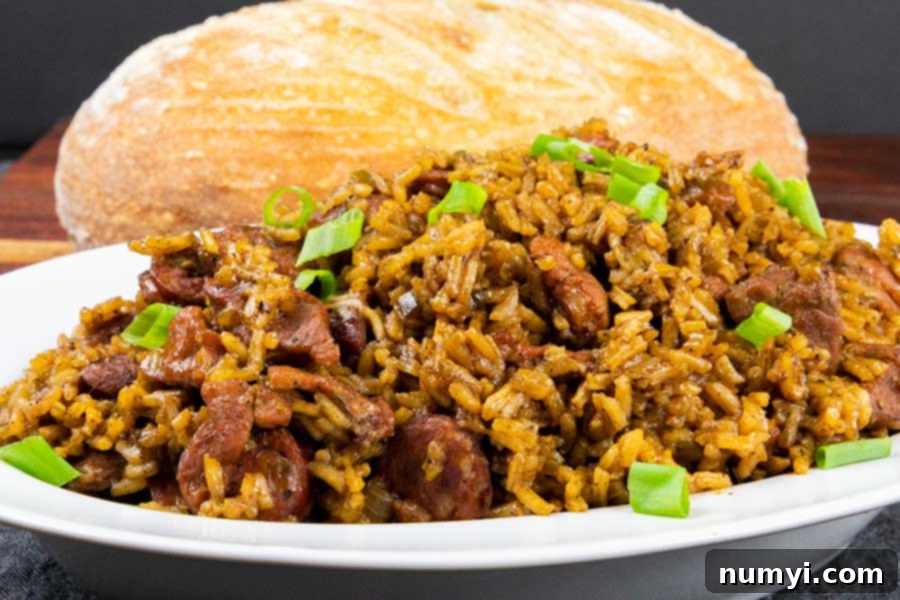Authentic Cajun Jambalaya Recipe: A Taste of New Orleans in Your Kitchen
Get ready to infuse your home with the vibrant spirit and rich flavors of Louisiana with this incredible Cajun jambalaya recipe. It’s more than just a dish; it’s a culinary journey that brings the soulful essence of New Orleans, reminiscent of Bourbon Street, right to your dining table!
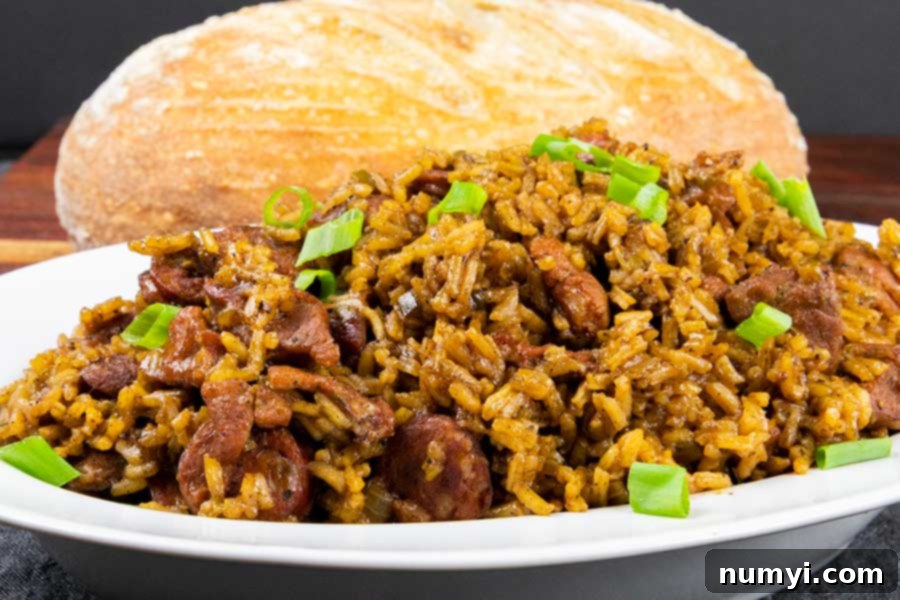
Cajun Jambalaya stands as a cornerstone of Louisiana cuisine, a truly quintessential dish. It’s a rice-based marvel, appearing deceptively simple yet boasting a complex depth of flavor, traditionally prepared with various meats such as sausage, pork, and sometimes seafood. The specific combination often reflects the cook’s personal touch and regional preference, making each pot a unique experience.
The Quest for the Perfect Cajun Jambalaya
Over our more than two decades of marriage, my partner and I have cooked countless pots of jambalaya. While our homemade versions were always enjoyable, they often lacked consistency. We’d throw ingredients together, relying on instinct rather than a precise method, resulting in a good meal but not the truly extraordinary experience we craved.
Just a short drive from our home lies a beloved local restaurant, a place we frequent at least twice a month. Without fail, we order our usual favorites, but it’s their Cajun jambalaya that always captures my anticipation. Each time, it delivers the same impeccable flavor and perfect texture, a consistent masterpiece that solidified it as our gold standard.
As passionate food bloggers, it became clear that our collection was incomplete without an outstanding jambalaya recipe. The challenge was set: to recreate that unparalleled restaurant quality in our own kitchen.
Our journey began by exploring numerous other recipes, many of which leaned towards the Creole style. Unfortunately, most left us feeling underwhelmed. Some were bland, others overwhelmed by excessive heat, and a few tasted more like a simple Spanish rice than authentic Louisiana fare. None truly resonated with the rich, deep flavors we sought.
With no success in convincing our favorite restaurant to share their secret (yes, we tried!), we embarked on our own rigorous testing. Leigh and I meticulously cooked batch after batch of jambalaya, adjusting ingredients and techniques, until we finally achieved the exact flavor profile we had been chasing. The result surpassed all our expectations. In fact, during one of our final taste tests, I confidently discarded a restaurant leftover, knowing our homemade version was superior. We are thrilled to share this triumph with you.
Cajun vs. Creole: Understanding the Distinction
When discussing Louisiana cuisine, the terms “Cajun” and “Creole” often arise, and while both are rich and flavorful, there’s a key distinction. In essence, Creole cooking typically incorporates tomatoes, which lends a reddish hue to dishes, while traditional Cajun cuisine does not. This is why you’ll notice varying colors in jambalayas from different restaurants or recipes – some vibrant red, others a deeper, more rustic brown.
Neither style is inherently superior; it simply comes down to individual taste preferences. Both offer incredible culinary experiences unique to Louisiana.
However, for me, the Cajun style of cooking, especially when it comes to jambalaya, holds a special place. Its distinctive taste is unmistakable and evokes the very soul of Louisiana. When I crave authentic “Cajun” comfort food, it’s that deep, savory, tomato-free flavor that truly satisfies.
Why This Jambalaya Will Become Your New Favorite
What we particularly cherish about this specific recipe is its perfect texture. Our jambalaya isn’t overly “soupy” or wet; it’s a hearty, fork-friendly dish where the rice is perfectly cooked and infused with flavor. There’s nothing worse than needing a spoon to navigate a watery jambalaya, and with this recipe, that won’t be an issue.
This recipe features a classic combination of smoky andouille sausage and succulent pork, creating a robust and deeply satisfying flavor base. While we advocate for this traditional pairing for an authentic experience, jambalaya is wonderfully versatile. Feel free to customize it with other proteins you enjoy, such as tender shrimp or juicy chicken, to suit your preferences. The beauty of jambalaya lies in its adaptability, allowing you to make it truly your own.
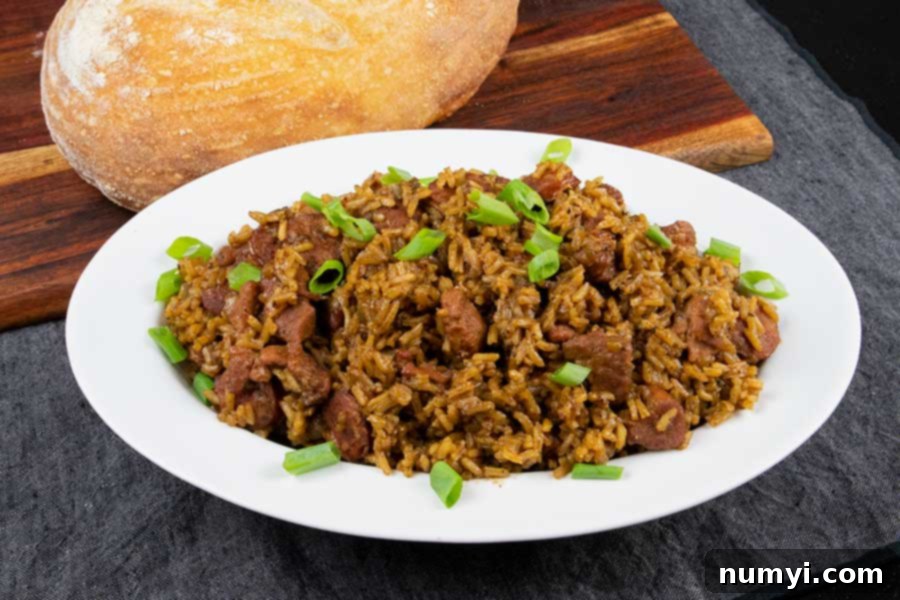
Essential Ingredients for Authentic Cajun Jambalaya
To achieve the rich, authentic flavors and satisfying textures that define truly exceptional jambalaya, we’ve focused on classic ingredients. For those just starting out, we highly recommend sticking to this traditional combination of pork and sausage, then feel free to explore variations once you’ve mastered the core recipe.
- Meats – Our recipe calls for high-quality Andouille sausage and diced pork (we prefer pork shoulder or butt for its rich flavor and tenderness when diced small). These are crucial for the smoky, savory base.
- The Holy Trinity – The cornerstone of Cajun and Creole cuisine: finely diced onion, celery, and bell pepper. These vegetables form the aromatic foundation, slowly cooked down to release their sweet and savory notes.
- Liquids – Good quality chicken stock or chicken broth is essential. If you have homemade chicken stock, it will elevate the flavor significantly.
- Rice – Long grain white rice is specified for this jambalaya recipe. Its texture absorbs flavors beautifully without becoming overly starchy or mushy.
- Seasonings – A carefully selected blend including tomato paste (a small amount for depth, not color for Cajun), Kitchen Bouquet (for color and savory depth), seasoning salt, fresh garlic, dried oregano, dried thyme, and Old Bay Seasoning. These spices are key to building the complex, layered flavors.
Mastering the Art of Cajun Jambalaya: A Step-by-Step Guide
The secret to a truly outstanding Cajun jambalaya lies in meticulous preparation. Dedicate some time to the prep work upfront, and you’ll find that the cooking process itself comes together surprisingly quickly and easily, leading to a flavorful and well-executed dish.
Begin by dicing your onion, celery, and green bell pepper – the “Holy Trinity” – into very small, uniform pieces. The smaller you cut them, the better. This fine dice allows the vegetables to essentially melt into the dish as they cook, releasing their flavors and contributing to the overall taste rather than standing out as distinct chunks in the finished jambalaya.
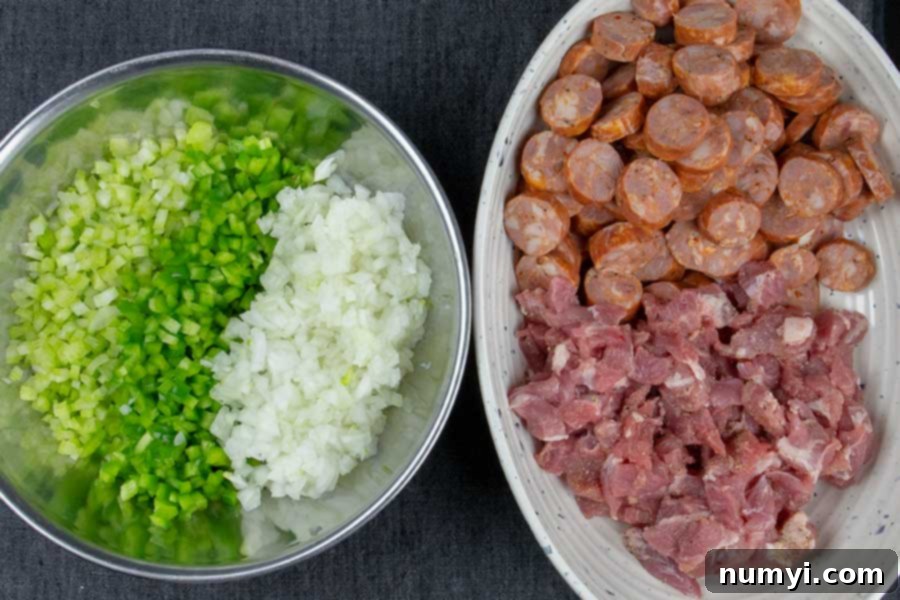
Next, prepare your meats. Slice the andouille sausage into thin, even rounds. For the pork, dice it into small, bite-sized pieces, carefully trimming away any large pieces of fat or connective tissue. The goal is to ensure that every forkful of jambalaya offers a balanced mix of flavors and textures, not just one large piece of meat dominating the bite.
In a small bowl, combine your pork seasonings: garlic powder, onion powder, kosher salt, and black pepper. Sprinkle this aromatic blend over your diced pork pieces and toss thoroughly to ensure they are evenly coated. This step is crucial for building flavor directly into the meat.
Now, it’s time to cook. Place a heavy-bottomed pot or Dutch oven over medium-high heat and add the olive oil, allowing it to heat until shimmering. A Dutch oven is highly recommended for its even heat distribution, which is vital for developing rich flavors without burning.
Add the seasoned pork to the hot pot. Sear the pork until it’s beautifully browned on all sides, a process that takes approximately 7 minutes. Don’t rush this step; allow the pork to sit undisturbed for a few minutes to develop a delicious caramelization, which adds immense depth of flavor to the dish. Once browned, remove the pork from the pot and set it aside.
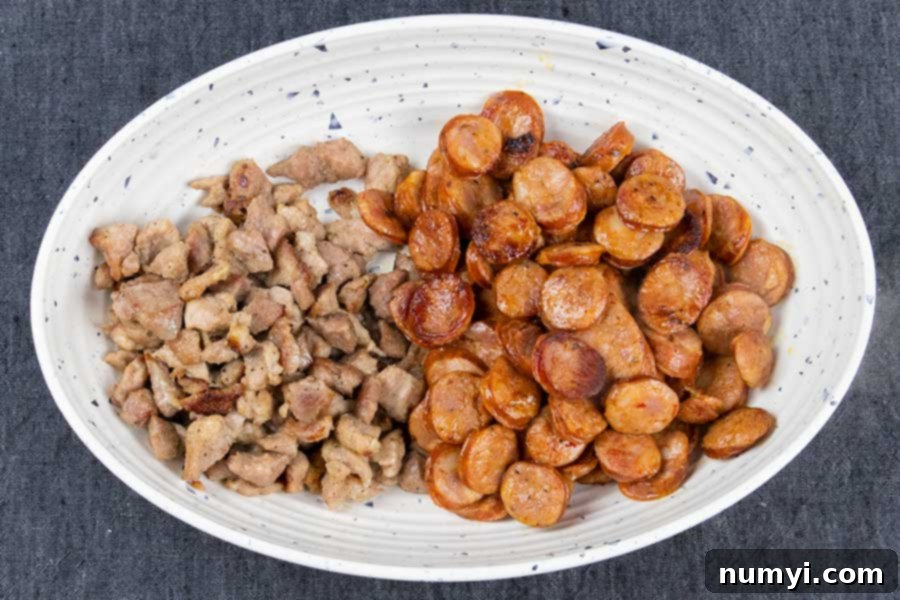
Add the sliced andouille sausage to the same pot and brown for approximately 5 minutes. Like the pork, this step renders some fat and adds another layer of smoky, savory flavor. Remove the sausage and set it aside with the pork.
Reduce the heat to medium, then add the diced onions, celery, and bell pepper (the Holy Trinity) to the pot. Cook these vegetables for about 7 minutes, stirring occasionally, until they soften and wilt. As you stir, make sure to scrape any flavorful browned bits of pork and sausage from the bottom of the pan – this fond is packed with deliciousness and will be incorporated into the sauce.
Next, add the minced garlic and tomato paste to the pot. Continue to cook for about 2 more minutes, stirring frequently. The tomato paste will deepen in color and flavor, adding a subtle richness without making the jambalaya “Creole” in style.
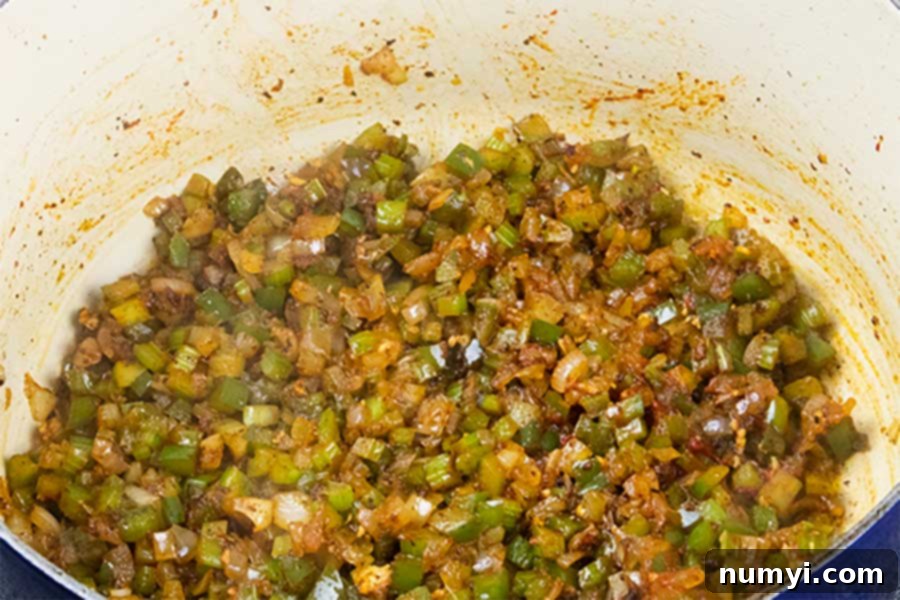
At this point, your vegetables should be tender, and the mixture in the pot should have a darker, richer color from the caramelized bits and juices from the meats. This indicates a well-developed flavor base.
Return the browned pork and sausage to the pot. Add the chicken stock, Kitchen Bouquet, seasoning salt, dried thyme, dried oregano, and Old Bay seasoning. Bring the entire mixture to a rolling boil.
Stir in the long-grain white rice and allow the pot to return to a boil. Once boiling, cover the pot tightly and reduce the heat to a low simmer. Cook for 10 minutes without lifting the lid.
After 10 minutes, quickly remove the cover and gently turn the rice from the bottom to the top to ensure even cooking and prevent sticking. Re-cover the pot tightly and continue to cook for an additional 15 to 20 minutes, or until the rice is tender and all the chicken stock has been fully absorbed.
A quick note on rice: This recipe is designed for long grain white rice. If you opt to use brown rice, be aware that it will require a longer cooking time and typically more liquid to reach the desired tenderness. Adjust accordingly if making this substitution.
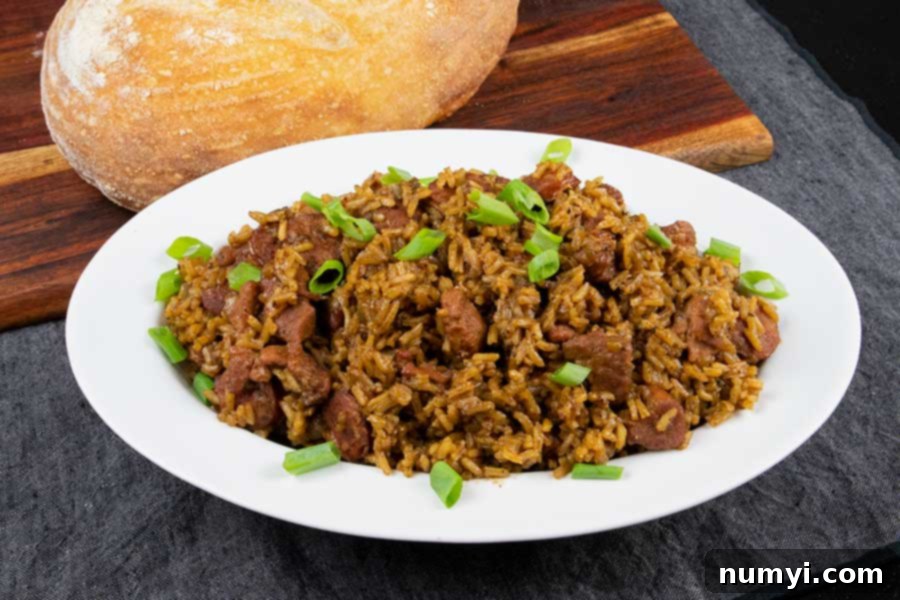
Once cooked, remove the pot from the heat. Allow it to rest for a few minutes, then fluff the rice gently before serving. Garnish with freshly chopped green onions or parsley for a burst of freshness and color.
Conclusion: Our Favorite Jambalaya Recipe
We are absolutely thrilled with this recipe! Our initial goal was to get as close as possible to the best-tasting jambalaya we had ever experienced, and we genuinely believe we’ve not only met but exceeded that standard. We put this recipe through rigorous testing, trying countless variations until we achieved this perfection.
To truly embrace the full Bourbon Street experience, consider serving this hearty jambalaya alongside a decadent Bread Pudding with Bourbon Sauce. It’s another iconic New Orleans dessert that we’ve perfected, and it offers a sweet, rich contrast to the savory main course – a guaranteed crowd-pleaser!
A crucial insight we gained during our recipe development was the profound impact of the sausage choice on the overall flavor. We experimented with various smoked sausages, different brands of andouille, and even a local butcher’s specialty sausage. The flavor profile of the jambalaya shifted dramatically with each change. This highlights that while our recipe is robust, the specific type of sausage you choose will significantly influence the final taste.
Therefore, if you have a favorite brand or type of sausage, we encourage you to use it! If you’re unsure where to start, we highly recommend the following type of Andouille sausage:
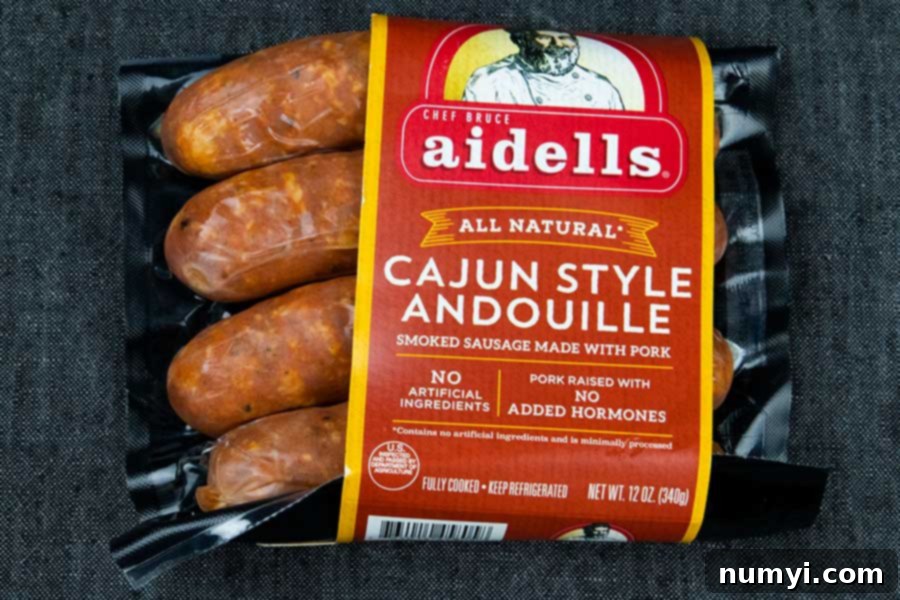
Please note, we are not compensated for this recommendation; we are simply sharing what delivered the best results in our kitchen. While there are undoubtedly other excellent options, and even a good smoked sausage would work well, this particular choice consistently provided the desired authentic flavor for us.
We sincerely hope you try this recipe. We’re confident that it will become a staple in your home and might just “blow your socks off”! As for us, now when we visit our favorite restaurant, I can finally order their delicious gumbo, knowing I’ve mastered their jambalaya at home.
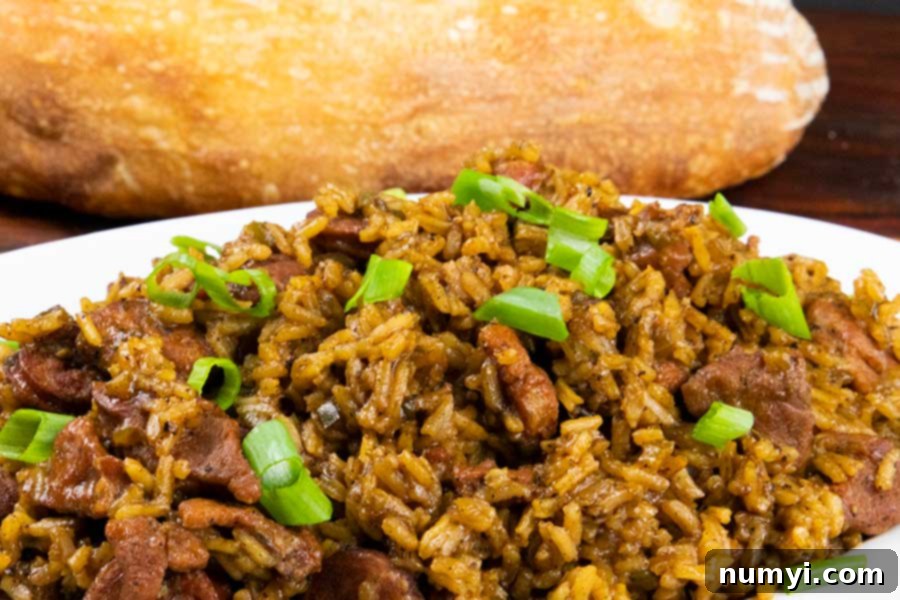
Allow the jambalaya to cool completely to room temperature. Transfer it to an airtight container and refrigerate for up to 4 days. This ensures its freshness and prevents bacterial growth.
Yes, you can freeze this jambalaya recipe, especially since it does not contain shrimp, which can alter in texture upon freezing and reheating. Allow the jambalaya to cool completely to room temperature, then place it in a freezer-safe container or heavy-duty freezer bag. Freeze for up to 2 months for optimal quality. Please keep in mind that the rice might become slightly mushier after freezing and thawing. When reheating, you may need to add a small amount of chicken stock or water to restore moisture.
Explore More Delicious Cajun & Creole Recipes
- How to Make Cajun Dirty Rice
- One Pan Chicken and Dirty Rice
- Hearty Shrimp and Sausage Gumbo
- Classic Creole Cornbread Recipe

Cajun Jambalaya Recipe
Print
Pin
Rate
Ingredients
The Holy Trinity – Equal parts Bell Pepper, Onion, and Celery (standard base for most cajun and creole cooking)
- 1 Bell Pepper Finely diced
- 1 Large Onion Finely diced
- 4 Celery stalks Finely diced
Proteins
- 1 lb Andouille sausage sliced
- 1 lb Pork diced into small pieces
Seasonings for pork
- 1/2 tsp Garlic powder
- 1/2 tsp Onion powder
- 1/2 tsp Kosher salt
- 1/2 tsp Black pepper
Spices and other ingredients needed
- 2 cups Long Grain White Rice
- 3.5 cups Chicken stock
- 2 tbsp Olive oil or vegetable oil
- 1 tbsp Kitchen Bouquet
- 1 tbsp Tomato paste
- 1 tbsp Seasoning salt
- 3 Garlic cloves finely diced, approximately 2 tsp.
- 1/2 tsp Dried oregano
- 1/2 tsp Dried thyme
- 1/2 tsp Old Bay seasoning
Garnish
- 1/2 cup Green onions chopped, optional
- 1/4 cup Parsley chopped, optional
Instructions
Prep
-
Dice onions, celery, and bell pepper into small pieces. Set aside.
-
Cut andouille into thin rounds. Set aside.
-
Cut pork into very small pieces, removing fat and any connective tissue. Set aside.
-
In a small bowl combine the garlic powder, onion powder, kosher salt, and black pepper.1/2 tsp Garlic powder, 1/2 tsp Onion powder, 1/2 tsp Kosher salt, 1/2 tsp Black pepper
Cook
-
Heat oil in large pot or dutch oven over medium-high heat.2 tbsp Olive oil
-
Sprinkle the pork seasoning over the meat and toss to coat evenly.
-
Add the seasoned pork to the pot and brown for approximately 7 minutes, allowing it to caramelize on all sides. Set aside.1 lb Pork
-
Add andouille sausage to the pot and brown for approximately 5 minutes. Set aside with the pork.1 lb Andouille sausage
-
Add onions, celery, and bell pepper to the pot. Reduce heat to medium and cook for approximately 7 minutes, stirring occasionally and scraping the bottom of the pan to release any flavorful browned bits from the pork and sausage.1 Large Onion, 4 Celery stalks, 1 Bell Pepper
-
Add the chopped garlic and tomato paste and cook for 2 minutes, stirring occasionally, allowing the flavors to meld.3 Garlic cloves, 1 tbsp Tomato paste
-
Return the pork and sausage to the pot. Add chicken stock, Kitchen Bouquet, seasoning salt, dried thyme, dried oregano, and Old Bay seasoning. Bring the mixture to a full boil.3.5 cups Chicken stock, 1 tbsp Kitchen Bouquet, 1 tbsp Seasoning salt, 1/2 tsp Dried oregano, 1/2 tsp Dried thyme, 1/2 tsp Old Bay seasoning
-
Add the rice, stir to combine, and return the pot to a boil.2 cups Long Grain White Rice
-
Cover the pot tightly and reduce the heat to a low simmer. Cook for 10 minutes without lifting the lid.
-
Remove the cover briefly and quickly turn the rice, gently folding the bottom to the top to ensure even cooking.
-
Re-cover the pot and cook for an additional 15 to 20 minutes, or until the rice is tender and all the chicken stock has been absorbed.
-
Remove the pot from the heat and let it rest, covered, for a few minutes before serving.
-
Garnish with chopped green onion or parsley (optional) just before serving.1/2 cup Green onions, 1/4 cup Parsley
Notes
For best results and even cooking, a heavy cast iron Dutch oven is ideal. However, a large, thick-bottomed pot with a well-fitting lid will also work effectively.
Storing Leftovers – Ensure the jambalaya cools completely to room temperature before transferring it to an airtight container. It can be refrigerated for up to 4 days.
Freezing Information – While rice can sometimes become mushier after freezing, you can freeze this dish (excluding shrimp, which holds up better without it). Place in a freezer-safe container or bag and freeze for up to 2 months for best quality. When reheating from frozen, you might want to add a little extra chicken stock to restore moisture and consistency.
